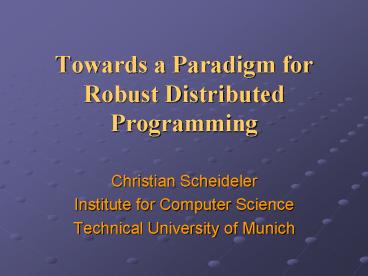Towards a Paradigm for Robust Distributed Programming PowerPoint PPT Presentation
1 / 28
Title: Towards a Paradigm for Robust Distributed Programming
1
Towards a Paradigm for Robust Distributed
Programming
- Christian Scheideler
- Institute for Computer Science
- Technical University of Munich
2
Performance measures
- Classical research areaEfficient algorithms and
data structures - Distributed computingEfficiency is not
everything!Robustness against adversarial
behavior increasingly pressing issue.
Topic of this talk
3
Four Commandments of Distributed Computing
- You shall not sleep.
- You shall not lie.
- You shall not steal
- You shall not kill
- Countermeasures for violations
- Algorithmic solutions if majority is prompt.
- Secure multiparty computation, filtering.
- No intrusion possible, then cryptographic
mechanisms protect against identity theft. - Serious problem! Denial-of-Service attacks!
4
Fundamental Dilemma
- Scalability minimize resources needed for
operations - Robustnessmaximize resources needed for attack
- Scalable solutions easy to attack!!!
5
Consequence
- We need a new model!
- NOT What is the current state? Current
distributed computing environment
fundamentally flawed. - What is a realizable state?
- Algorithms can be powerful advocates!
6
Towards a new paradigm
- Requirements
- Universalitywide range of comp./comm.
environments - Simplicitysimple to state, realize and apply
- Efficiencyinexpensive to realize and apply
- Robustness???
7
Laws of Robustness
- K. Cameron The laws of identity, D. Epp The
eight rules of security, - User consent and controluser should have full
control over its resources at any time - Minimal exposureonly give enough information to
perform task - Minimal authorityonly give enough authority for
task (principle of least privilege/authority)
8
Medical privacy
- EU Rec. on Protection of Medical Data 1997,
U.S. OCR HIPAA Regulations - User consent and controlpatients should have
knowledge of /control over their medical data - Minimal exposureonly store/reveal information
necessary for diagnosis or treatment - Minimal authorityonly give enough authority for
task (principle of least privilege/authority)
9
Towards a new paradigm
- Requirements
- Universalitywide range of comp./comm.
environments - Simplicitysimple to state, realize and apply
- Efficiencyinexpensive to realize and apply
- Robustnessthree laws
10
Universal Models
- Turing machineeasy to state and realize but not
to apply - von Neumann machineeasy to state but not to
realize in distributed environment - Pointer modelslooks like most promising
direction
11
Subject-oriented approach
- Subjects active entities (no dynamic data!)
- Objects passive entities (no methods!)(hulls
for dynamic data) - no global user-accessible references to subjects
or objects (minimizes exposure) - Subjects and objects atomic
- Every object accessible by only one subject at
any time and must be co-located with it - Information exchange through exchange of objects
along relay points
12
Subject-oriented approach
- Precursor Hewitts Actor model 1973
- Since then mostly work in programming languages
(E Language by Miller et al.) - Simplicity concurreny is difficult!
- ) concurrency only outside of subjects
- ) only strictly non-blocking primitives
- ) no global read and write!
13
Subject-oriented approach
- Ingredients
- Subjects threads with static data
- Objects hulls of dynamic data
- Relay points communication
- Identities objects for authorization
14
Laws of Robustness
- User consent and control- subjects objects
are atomic, subjects tied to site and objects
co-located with subjects - parents are
responsible for children - Minimal exposure- subjects objects have no
identity, only relays- no sensitive information
(keys) revealed - Minimal authorityany connection/access requires
permission
Realize these through create delete
15
Subjects
- p(s) parent of s (cannot be changed!)
- s.create(s) sp(s)
- s.delete(s) if sp(s) then delete s and all
of its descendents
16
Relay points
- h(r) home of relay r (cannot be changed!)
- s.create(r)
- s.create(r i) if d(i)s
- s.delete(r) if h(r)s then delete r
outgoing link can not be changed
s
17
Identities
- d(i) 2 R 1 destination
- s.create(i) d(i)1 (public identity)
- s.create(i r) d(i)p(s)
- s.create(i r,i) d(i)s(i) (s source of i)
- s.delete(i)
18
First contact
19
Introduction
r
r
C
20
Objects
- We already know
- Objects are type-less hulls of dynamic data and
co-located with their subjects - Identities are special objects
- Further concepts
- For efficiency, only object references
transferred in internal communication, but whole
objects in external communication - Migration of subjects through special objects
called clones
21
Clones
- s(c) source, d(c) destination
- s.create(c) d(c)p(s)
- s.create(c i) d(c)s(i)
- s.create(s c)
22
Working with objects
- Initialization of objectsobj new Object
(removes all old info)obj1 obj2 not possible
(else access conflicts!) - Initialization of a new variable in object
objint obj.var1 1float obj.var2 0.2
string obj.var3 name - Test of defined variableif obj.name NULL then
var1 1
23
Working with objects
- Copy-operationobj1.name1 obj2.name2
- Move-operationobj1.name1 lt- obj2.name2
obj2.name2 set to NULL - Referencingapproach store variable names in
variablesvar1 2 some lokal variable in
subjectobj.var1 1 obj.var1 resolves
to obj.2 var2 name obj.var2 1
obj.var2 resolves to obj.name - Delete-operationobj.name NULL
24
Better resource control
- Additional commands open and close.
- open(Subject s) activates s
- close(Subject s) freezes (and saves) s
- open(Relay r) activates r
- close(Relay r) freezes (and saves) r
- open(Object o) opens o for operations
- close(Object o) closes (and saves) o
- New subjects/relays/objects initially open.
25
Better resource control
- In addition, use policies
- Policies for permitted calls along links.
- Policies for resource use of subject and its
descendents. - Still under development
26
Nice features
- Rigorous designs of systems possible that are
robust against identity theft and DoS attacks - Secure grid computing
- Digital rights management
- Anonymity and privacy
- BUT How to realize subjects environment?
27
Implementation
User
Internet
ISP
- User subjects internal relay points
- ISP external relay points (quota)
28
Questions? Contact scheideler_at_in.tum.de

